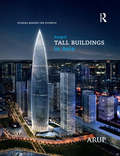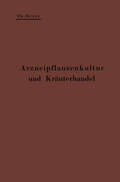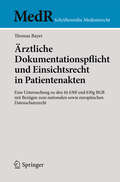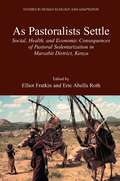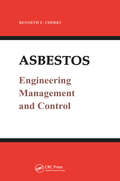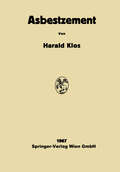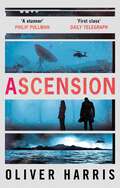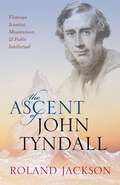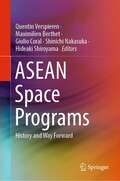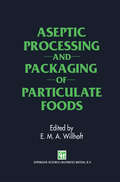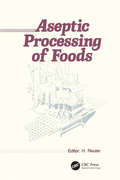- Table View
- List View
Arup’s Tall Buildings in Asia: Stories Behind the Storeys
by Goman Wai-Ming HoThrough a series of detailed case studies from East Asia, Arup, one of the global leaders in tall building design, presents the latest developments in the field to inspire more innovative and sustainable ideas in tall building design and engineering. This book exhibits the key design aspects of tall buildings in 20 case studies, from China, Singapore, Hong Kong, Vietnam and Japan. Chapters cover design and construction, safety concerns, sustainability strategies, BIM and optimisation solutions, and include contributions from the actual project engineers. The projects chosen are not the tallest buildings, but all of them have been selected for their significant engineering insights and values. Arup’s engineers explain the design principles, and how they overcame various design constraints and challenges, while exceeding their clients’ expectations. Unique examples include: the design and application of a hybrid outrigger system in the Raffles City Chongqing project the challenges encountered in the construction of the CCTV Headquarters, Beijing as well as Tianjin’s Goldin Finance 117 Tower, Ho Chi Minh City’s Vincom Landmark 81, the China Resources Headquarters, Ping An IFC, Tokyo’s Nicolas G Hayek Center and the Shanghai World Financial Centre. These varied and complex cases studies draw on multi-disciplinary design and engineering challenges which make this book essential reading for architects, structural engineers, project managers and researchers of high-rise buildings. The book also provides a usual reference and link between practitioners in the industry, academia and engineering students.
Aryl Diazonium Salts and Related Compounds: Surface Chemistry and Applications (Physical Chemistry in Action)
by Mohamed M. Chehimi Jean Pinson Fatima MousliThis volume provides the latest developments in the field of surface science and technology based on diazonium coupling agents as well as their precursors (e.g. aromatic amines). It presents new concepts of surface chemistry of diazonium salts and discusses their novel and challenging applications. The latest advances on surface modification with diazonium salts are discussed and various promising alternative surface modifiers such as iodonium salts are examined. This book demonstrates the universality of diazonium salts in the surface treatment of classical and emergent materials and it will be a great tool for researcher and graduates working in this field.
Arzneipflanzenkultur und Kräuterhandel: Rationelle Züchtung, Behandlung und Verwertung der in Deutschland zu ziehenden Arznei- und Gewürzpflanzen; Eine Anleitung für Apotheker, Landwirte und Gärtner
by Theodor MeyerDieser Buchtitel ist Teil des Digitalisierungsprojekts Springer Book Archives mit Publikationen, die seit den Anfängen des Verlags von 1842 erschienen sind. Der Verlag stellt mit diesem Archiv Quellen für die historische wie auch die disziplingeschichtliche Forschung zur Verfügung, die jeweils im historischen Kontext betrachtet werden müssen. Dieser Titel erschien in der Zeit vor 1945 und wird daher in seiner zeittypischen politisch-ideologischen Ausrichtung vom Verlag nicht beworben.
Ärztliche Dokumentationspflicht und Einsichtsrecht in Patientenakten: Eine Untersuchung zu den §§ 630f und 630g BGB mit Bezügen zum nationalen sowie europäischen Datenschutzrecht (MedR Schriftenreihe Medizinrecht)
by Thomas BayerDieses Buch analysiert die Rechtslage in Bezug auf Patientenakten in Deutschland. Es behandelt schwerpunktmäßig die ärztliche Dokumentationspflicht, das Einsichtsrecht des Patienten in seine Behandlungsunterlagen sowie Fragen zur gesetzlich vorgeschriebenen Aufbewahrung und Archivierung. Die Darstellung orientiert sich dabei sowohl am neuen Behandlungsvertragsrecht der §§ 630a ff. BGB als auch an den standesrechtlichen Vorgaben der ärztlichen Berufsordnungen. Daneben diskutiert es Lösungsvorschläge für bisher noch offene Rechtsfragen im Bereich des postmortalen Einsichtsrechts der Erben und Angehörigen sowie zum Umgang mit sensiblen Inhalten, die einer Einsichtnahme durch den Patienten im Einzelfall entzogen sind. Ein weiterer Abschnitt behandelt wesentliche Schnittstellen zum nationalen und europäischen Datenschutzrecht, insbesondere zum Auskunftsanspruch nach Art. 15 DSGVO. Erwähnung finden ferner die sozialrechtlichen Regelungen zur Einführung der elektronischen Gesundheitskarte.
As Pastoralists Settle: Social, Health, and Economic Consequences of the Pastoral Sedentarization in Marsabit District, Kenya (Studies in Human Ecology and Adaptation #1)
by Elliot Fratkin Eric Abella RothThroughout the world's arid regions, and particularly in northern and eastern Africa, formerly nomadic pastoralists are undergoing a transition to settled life. This reference shows that although pastoral settlement is often encouraged by international development agencies and national governments, the social, economic and health consequences of sedentism are not inevitably beneficial.
Asbestos: Directory of Unpublished Studies
by S. AmaducciFirst Published in 1986. Routledge is an imprint of Taylor & Francis, an informa company.
Asbestos: Directory of Unpublished Studies
by S. AmaducciFirst Published in 1986. Routledge is an imprint of Taylor & Francis, an informa company.
Asbestos: Engineering, Management and Control
by Kenneth F. CherryThis single source asbestos reference/text book incorporates major legal issues and cost estimating methods. Every aspect of abatement work from initial survey through final cleanup is detailed. In addition, medical aspects, respirator use, training, sample contracts and other topics, coupled with a practical approach, make this the book to have when the goal is to get the job done. The book contains lots of valuable information and data, including CFR 1910 and NFPA 220/241, and will serve as an ideal reference source for asbestos contractors, building owners, industrial hygienists, consultants, and schools.
Asbestos: Engineering, Management and Control
by Kenneth F. CherryThis single source asbestos reference/text book incorporates major legal issues and cost estimating methods. Every aspect of abatement work from initial survey through final cleanup is detailed. In addition, medical aspects, respirator use, training, sample contracts and other topics, coupled with a practical approach, make this the book to have when the goal is to get the job done. The book contains lots of valuable information and data, including CFR 1910 and NFPA 220/241, and will serve as an ideal reference source for asbestos contractors, building owners, industrial hygienists, consultants, and schools.
Asbestos: Risk Assessment, Epidemiology, and Health Effects
by Michele Carbone, Ronald F. Dodson, Harvey Pass, and Haining YangAsbestos: Risk Assessment, Epidemiology, and Health Effects offers a key text on the evolving information regarding asbestos and human health. Now in its third edition, this bestseller explores the pathological complexities of asbestos-related disease and examines how asbestos induces diseases in biological systems. The book also discusses the types of instruments and methods available for evaluation of the content of asbestiform minerals in products, air, water, surface areas, and tissue. It explains the relevance of each of these applications and gives readers the tools to evaluate data in the future.Edited by leading authorities on the subject and with contributions from a team of international experts, this book takes a cross-disciplinary approach and an authoritative review of the history, pathology, epidemiology, sampling, and analysis of asbestos. Backed up with photos and numerous diagrams, tables, and photographs, it features case studies, methodologies, and sampling/analytical schemes that put learning into context. Fully up-to-date and featuring four brand new chapters covering asbestosis and immunity, asbestos litigation and surgical and non-surgical management of mesothelioma, this book remains the most comprehensive source of information on asbestos and the only guide the reader will ever need to own.This essential text will appeal to any professional at any level who requires the latest expertise in dealing with asbestos. It suits researchers and practitioners alike, as well as those in the fields of law, health, education, hospitality, emergency response, building management and maintenance, construction, safety, insurance, and industrial hygiene.
Asbestos: Risk Assessment, Epidemiology, and Health Effects
Asbestos: Risk Assessment, Epidemiology, and Health Effects offers a key text on the evolving information regarding asbestos and human health. Now in its third edition, this bestseller explores the pathological complexities of asbestos-related disease and examines how asbestos induces diseases in biological systems. The book also discusses the types of instruments and methods available for evaluation of the content of asbestiform minerals in products, air, water, surface areas, and tissue. It explains the relevance of each of these applications and gives readers the tools to evaluate data in the future.Edited by leading authorities on the subject and with contributions from a team of international experts, this book takes a cross-disciplinary approach and an authoritative review of the history, pathology, epidemiology, sampling, and analysis of asbestos. Backed up with photos and numerous diagrams, tables, and photographs, it features case studies, methodologies, and sampling/analytical schemes that put learning into context. Fully up-to-date and featuring four brand new chapters covering asbestosis and immunity, asbestos litigation and surgical and non-surgical management of mesothelioma, this book remains the most comprehensive source of information on asbestos and the only guide the reader will ever need to own.This essential text will appeal to any professional at any level who requires the latest expertise in dealing with asbestos. It suits researchers and practitioners alike, as well as those in the fields of law, health, education, hospitality, emergency response, building management and maintenance, construction, safety, insurance, and industrial hygiene.
Asbestos for Surveyors
by Bill SandersonAsbestos for Surveyors is a practical reference guide for all those responsible for identifying and dealing with asbestos in buildings. The book is based upon the Control of Asbestos at Work Act 2002 and is intended to be a guide to the technical aspects of asbestos and why it was originally used. It illustrates where it may be found in buildings, what type of survey is required and how to undertake it. The information that the dutyholder needs from the surveyor to compile an adequate management plan is also detailed. This edition has been fully revised to take account of the Control of Asbestos Regulations 2006 (SI 2006/2739), which came into force in November 2006. The regulations, which replaced three existing sets of asbestos regulations with a single set of rules, reduce exposure limits and introduce mandatory training for those working with asbestos.
Asbestos for Surveyors
by Bill SandersonAsbestos for Surveyors is a practical reference guide for all those responsible for identifying and dealing with asbestos in buildings. The book is based upon the Control of Asbestos at Work Act 2002 and is intended to be a guide to the technical aspects of asbestos and why it was originally used. It illustrates where it may be found in buildings, what type of survey is required and how to undertake it. The information that the dutyholder needs from the surveyor to compile an adequate management plan is also detailed. This edition has been fully revised to take account of the Control of Asbestos Regulations 2006 (SI 2006/2739), which came into force in November 2006. The regulations, which replaced three existing sets of asbestos regulations with a single set of rules, reduce exposure limits and introduce mandatory training for those working with asbestos.
Asbestos The Hazardous Fiber
by Melvin A. BenardeWith the passage of the Asbestos Hazard Emergency Response Act, AHERA, Public Law 99-519, it was clear that great quantities of asbestos would be disturbed and would require proper management and disposal. If these were poorly done, many people would be placed at risk unnecessarily.Into such an environment, a book dealing with the many diverse facets of asbestos abatement, written by people with substantial experience, seemed reasonable and appropriate, but even more so, necessary.
Asbestos The Hazardous Fiber
by Melvin A. BenardeWith the passage of the Asbestos Hazard Emergency Response Act, AHERA, Public Law 99-519, it was clear that great quantities of asbestos would be disturbed and would require proper management and disposal. If these were poorly done, many people would be placed at risk unnecessarily.Into such an environment, a book dealing with the many diverse facets of asbestos abatement, written by people with substantial experience, seemed reasonable and appropriate, but even more so, necessary.
Asbestzement: Technologie und Projektierung
by Harald KlosIn Gesprächen mit Asbestzement-Erzeugern, Betriebsleitern, Betriebs leuten und Technologen sowie mit auf diesem Gebiet tätigen Maschinen bauern, Projektanten, Konstrukteuren und für die Inbetriebsetzung ver antwortlichen Technikern konnte ich immer wieder feststellen, wie sehr das Fehlen ausreichender Literatur über Asbestzement als Mangel empfunden wird. Dabei konnte ich zusätzlich feststellen, daß selbst die vorhandene Asbestzement-Literatur viel zuwenig bekannt ist. Daraus resultierte mein Entschluß, manohes, was in der Literatur aufzufinden war, sowie einiges von den Erfahrungen, die ich als projektierender und konstruierender Ingenieur bei der Inbetriebsetzung mehrerer Anlagen und in Gesprächen mit Kunden und Interessenten gesammelt hatte, systematisch zu ordnen und in Form des vorliegenden Buches einem größeren Kreise zugänglich zu machen. Das Buch wendet sich in erster Linie an den praktisch tätigen Ingenieur. Von diesem Gesichtspunkt aus habe ich jene Abschnitte kürzer gehalten, die für den Praktiker von geringerer Bedeutung sind, und habe bewußt auf die Behandlung allzu spezieller Probleme verzichtet. Die Asbesttechnologie enthält noch viele Fragen, die nicht restlos geklärt sind. Meine Darstellung, die sich weitgehend auf eigene Erfahrungen stützt, ist daher an manchen Stellen notwendigerweise subjektiv. Ich hoffe jedoch, daß dies kein Mangel ist.
Ascension
by Oliver Harris'Oliver Harris's Ascension is a stunner. What a pleasure it is to read a book with a powerful story, an unusual and fully realised setting, a convincing hero, all written in a style of luminous clarity' Philip PullmanAscension: the most remote island in the world... Elliot Kane, former spy, trying to leave the world of espionage behind. Kathryn Taylor: a stalled career in MI6, running the South Atlantic desk. Rory Bannatyne: covert technical specialist. Dead, apparently of suicide. Three friends from a mission many years ago reconnect when one of them dies on Ascension Island. Rory Bannatyne had been tasked with tapping a new transatlantic data cable, but a day before he was due to return home he is found hanged. When Kathryn Taylor begs Kane to go over and investigate, he can't say no, but it's an uneasy reintroduction to the intelligence game. Ascension is a curious legacy of England's imperial past. Only employees and their families are allowed to live there. It's home to several highly-classified government projects, a British and American military base, and forty dead volcanic cones. Entirely isolated from the world, the disappearance of a young girl at the same time as Rory's death means local tensions are high. Elliot needs to discover what happened to her as well as to Rory. But the island contains more secrets than even the government knows, and it's not going to give them up without a fight.
The Ascent of GIM, the Global Intelligent Machine: A History of Production and Information Machines (History of Mechanism and Machine Science #36)
by Teun KoetsierIn the concluding chapters of this book the author introduces GIM, the Global Intelligent Machine. GIM is a huge global hybrid machine, a combination of production machinery, information machinery and mechanized networks. In the future it may very well encompass all machinery on the globe. The author discusses the development of machines from the Stone Age until the present and pays particular attention to the rise of the science of machines and the development of the relationship between science and technology. The first production and information tools were invented in the Stone Age. In the Agricultural empires tools and machinery became more complex. During and after the Industrial Revolution the pace of innovation accelerated. In the 20th century the mechanization of production, information processing and networks became increasingly sophisticated. GIM is the culmination of this development. GIM is no science fiction. GIM exists and is growing and getting smarter and smarter. Individuals and institutions are trying to control parts of this giant global robot. By looking at its history and by putting GIM in the context of the current developments, this book seeks to reach a fuller understanding of this phenomenon.
The Ascent of John Tyndall: Victorian Scientist, Mountaineer, and Public Intellectual
by Roland JacksonRising from a humble background in rural southern Ireland, John Tyndall became one of the foremost physicists, communicators of science, and polemicists in mid-Victorian Britain. In science, he is known for his important work in meteorology, climate science, magnetism, acoustics, and bacteriology. His discoveries include the physical basis of the warming of the Earth's atmosphere (the basis of the greenhouse effect), and establishing why the sky is blue. But he was also a leading communicator of science, drawing great crowds to his lectures at the Royal Institution, while also playing an active role in the Royal Society. Tyndall moved in the highest social and intellectual circles. A friend of Tennyson and Carlyle, as well as Michael Faraday and Thomas Huxley, Tyndall was one of the most visible advocates of a scientific world view as tensions grew between developing scientific knowledge and theology. He was an active and often controversial commentator, through letters, essays, speeches, and debates, on the scientific, political, and social issues of the day, with strongly stated views on Ireland, religion, race, and the role of women. Widely read in America, his lecture tour there in 1872-73 was a great success. Roland Jackson paints a picture of an individual at the heart of Victorian science and society. He also describes Tyndall's importance as a pioneering mountaineer in what has become known as the Golden Age of Alpinism. Among other feats, Tyndall was the first to traverse the Matterhorn. He presents Tyndall as a complex personality, full of contrasts, with his intense sense of duty, his deep love of poetry, his generosity to friends and his combativeness, his persistent ill-health alongside great physical stamina driving him to his mountaineering feats. Drawing on Tyndall's letters and journals for this first major biography of Tyndall since 1945, Jackson explores the legacy of a man who aroused strong opinions, strong loyalties, and strong enmities throughout his life.
The Ascent of John Tyndall: Victorian Scientist, Mountaineer, and Public Intellectual
by Roland JacksonRising from a humble background in rural southern Ireland, John Tyndall became one of the foremost physicists, communicators of science, and polemicists in mid-Victorian Britain. In science, he is known for his important work in meteorology, climate science, magnetism, acoustics, and bacteriology. His discoveries include the physical basis of the warming of the Earth's atmosphere (the basis of the greenhouse effect), and establishing why the sky is blue. But he was also a leading communicator of science, drawing great crowds to his lectures at the Royal Institution, while also playing an active role in the Royal Society. Tyndall moved in the highest social and intellectual circles. A friend of Tennyson and Carlyle, as well as Michael Faraday and Thomas Huxley, Tyndall was one of the most visible advocates of a scientific world view as tensions grew between developing scientific knowledge and theology. He was an active and often controversial commentator, through letters, essays, speeches, and debates, on the scientific, political, and social issues of the day, with strongly stated views on Ireland, religion, race, and the role of women. Widely read in America, his lecture tour there in 1872-73 was a great success. Roland Jackson paints a picture of an individual at the heart of Victorian science and society. He also describes Tyndall's importance as a pioneering mountaineer in what has become known as the Golden Age of Alpinism. Among other feats, Tyndall was the first to traverse the Matterhorn. He presents Tyndall as a complex personality, full of contrasts, with his intense sense of duty, his deep love of poetry, his generosity to friends and his combativeness, his persistent ill-health alongside great physical stamina driving him to his mountaineering feats. Drawing on Tyndall's letters and journals for this first major biography of Tyndall since 1945, Jackson explores the legacy of a man who aroused strong opinions, strong loyalties, and strong enmities throughout his life.
Ascorbic Acid in Plant Growth, Development and Stress Tolerance
by Mohammad Anwar Hossain Sergi Munné-Bosch David J. Burritt Pedro Diaz-Vivancos Masayuki Fujita Argelia LorenceAscorbic acid (AsA), vitamin C, is one of the most abundant water-soluble antioxidant in plants and animals. In plants AsA serves as a major redox buffer and regulates various physiological processes controlling growth, development, and stress tolerance. Recent studies on AsA homeostasis have broadened our understanding of these physiological events. At the mechanistic level, AsA has been shown to participate in numerous metabolic and cell signaling processes, and the dynamic relationship between AsA and reactive oxygen species (ROS) has been well documented. Being a major component of the ascorbate-glutathione (AsA-GSH) cycle, AsA helps to modulate oxidative stress in plants by controlling ROS detoxification alone and in co-operation with glutathione. In contrast to the single pathway responsible for AsA biosynthesis in animals, plants utilize multiple pathways to synthesize AsA, perhaps reflecting the importance of this molecule to plant health. Any fluctuations, increases or decreases, in cellular AsA levels can have profound effects on plant growth and development, as AsA is associated with the regulation of the cell cycle, redox signaling, enzyme function and defense gene expression. Although there has been significant progress made investigating the multiple roles AsA plays in stress tolerance, many aspects of AsA-mediated physiological responses require additional research if AsA metabolism is to be manipulated to enhance stress-tolerance. This book summarizes the roles of AsA that are directly or indirectly involved in the metabolic processes and physiological functions of plants. Key topics include AsA biosynthesis and metabolism, compartmentation and transport, AsA-mediated ROS detoxification, as well as AsA signaling functions in plant growth, development and responses to environmental stresses. The main objective of this volume is therefore to supply comprehensive and up-to-date information for students, scholars and scientists interested in or currently engaged in AsA research.
ASEAN Space Programs: History and Way Forward
by Hideaki Shiroyama Quentin Verspieren Maximilien Berthet Giulio Coral Shinichi NakasukaThis book presents the first-ever comprehensive analysis of ASEAN space development programs. Written by prominent actors in the region, it goes beyond a mere exposé of the history, current status and future plans of ASEAN space technology development and utilization programs, by analyzing the conditions in which a space program can be initiated in the region. It does so in two ways: on the one hand, it questions the relevance of and motivations behind the inception of space development programs in developing countries, and on the other hand, it focuses on the very specific context of ASEAN (a highly disaster-prone area shaped by unique political alliances with a distinctive geopolitical ecosystem and enormous economic potential, etc.). Last but not least, after having analyzed established and emerging space programs in the region, it provides concrete recommendations for any regional or extra-regional developing nation eager to gain a foothold in space. As such, this book offers a valuable resource for researchers and engineers in the field of space technology, as well as for space agencies and government policymakers.
Aseptic Processing and Packaging of Particulate Foods
by E. M. WillhoftPublications in food technology proliferate; however, noticeable by its absence of coverage is the subject of processing and packaging of particulates in foods. Recent years have seen significant advances which will almost certainly result in substitution of existing and conventional retorting. In addition, when com bined with high temperature/short time (HTST) processing, we can expect substantial further growth, reflecting quality and convenience advantages over products processed from yesterday's technologies. The anticipated growth in particulates is driven by both materials and packaging advances and only requires modest marketing of the organoleptic advantages to establish their place on menu options. The directions taken in packaging developments, especially those interfacing with the latest and established methods of processing, are increasingly influ enced by the need to design packaging on a cradle-to-grave basis. Time was when multi-laminated films on board satisfied the total needs of consumers of aseptic products. The problems of recycling combustible, i.e. energy generating mate rials laminated with aluminium foil, are becoming sensitive issues in a world preoccupied with recycling, and are creating openings for alternative and envi ronmentally friendly material combinations. This book brings together advanced technologies in the field, to provide information for professionals with interests in aseptic processing on how to go about selecting a system appropriate to their commercial needs and constraints.
Aseptic Processing of Foods
by Helmut ReuterAseptic food processing has become important as a safe and effective method for the preparing and packaging of a variety of foods. This recent book, prepared by a team of European specialists, provides a detailed guide and reference to aseptic food processing technology. All aspects are presented systematically: principles, practice, equipment, applications, packages and packaging, quality control, and safety. All applicable food and beverage categories are examined. More than 130 photographs, diagrams, and other schematics illustrate equipment and their function and a variety of procedures. Tables and graphs provide important quantitative data in convenient form.
